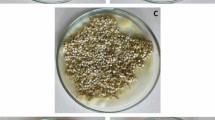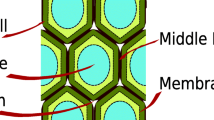Abstract
Guava (Psidium guajava) fruits of cv. L-49 with individual shrink wrapping using 9 μ LLDPE film could be successfully stored up to 12 days at ambient and 18 days in evaporative cool chamber with negligible loss in vitamin C content. The untreated fruits lose 25–30% of ascorbic acid within 1week after harvest. Delay in senescence and metabolic activities as supported by less changes in soluble solids, sugars, acidity, respiration, and ethylene evaluation rate was also observed in individual shrink wrapped fruits in cool chamber. The spoilage of fruits by Fusarium rots was significantly less in cool chamber in individually shrink wrapped fruits followed by Sta-fresh treatment. Sta-fresh was more effective in cool chamber than ambient. Individually stored wrapped fruits scored a better value of sensory score than Sta-fresh under both the storage condition.
Similar content being viewed by others
References
Dinamarca EA, Mitchell FG, Kader AA (1987) Use of sucrose esters as retardants of ripening of pears and plums. Rev Fruticola 19(3): 116–121.
Pekmezei M, Erkan M, Demirkol A (1995) The effect of harvest time and different postharvest applications on the storage of valencia oranges. Acta Horticult 398: 276–284.
Ben-Yehoshua S (1985) Individual seal packing of fruits and vegetables in plastic film—A new postharvest technique. Horticult Sci 20: 32–37.
Roy SK, Pal RK (1993) A low-cost cool chamber: An innovative technology for developing countries. In: Champ BR, Highley E, Johnson GI (eds), AICAR Proceedings on Postharvest Handling of Tropical Fruits, Australia, no. 50, pp 393–395.
AOAC (1970) Official Methods of Analysis, 11th edn. Washington, DC: Association of Official Analytical Chemists.
Gaillard T, Grey C (1969) A rapid method for determination of ethylene in presence of other volatile natural products. J Chromatogr 41: 442–452.
Amerine MA, Pangborn RM, Roessler EB (1965) Principles of Sensory Evaluation of Food. New York: AcademicPress.
Snedecor GW, Cochran WG (1967) Statistical Methods. New Delhi: Oxford and IBH, 593 pp.
Negi PS, Roy SK (2000) Effect of low cost storage and packaging on quality and nutritive value of fresh and dehydrated carrots. J Sci Food Agric 80: 2169–2175.
Greison W, Wardowski WF (1975) Humidity in horticulture. Horticult Sci 10: 356–360.
Jagdish SL, Rokhade AK, Lingarajan S (2001) Influence of post harvest treatments on storage behaviour of guava fruits cv. Sardar. J Maharashtra Agric Univ 26(3): 297–300.
McGuire RG, Hallman GJ (1995) Coating guavas with cellulose or carnuba based emulsions interferes with post harvest ripening. Horticult Sci 30(2): 294–295.
Author information
Authors and Affiliations
Corresponding author
Rights and permissions
About this article
Cite this article
PAL, R., AHMAD, M., ROY, S. et al. Influence of Storage Environment, Surface Coating, and Individual Shrink Wrapping on Quality Assurance of Guava (Psidium guajava) Fruits. Plant Foods Hum Nutr 59, 67–72 (2004). https://doi.org/10.1007/s11130-004-0022-5
Issue Date:
DOI: https://doi.org/10.1007/s11130-004-0022-5




